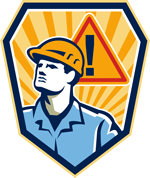Part 5 of 5: Bob and Joe have been friends since high school; they served as the best man at each others wedding and are godfathers to each others children. The two families often vacation together, their children go to the same schools, and they consider themselves fortunate that their careers in construction have allowed them to work together. On a particular lift Bob is rigging the loads while Joe handles the tag line. The operator was moving the load away from the crane, keeping the load close to the ground when Bob, who had his hand on the side of the load, suddenly collapsed. Joe was horrified and dropped the tag line and ran to help his friend. Joe never made it to Bob, as he too collapsed to the ground. The foreman then yelled for everyone to stay put.
Bob and Joe's story is a classic "I see my friend in trouble and I run to his aid" scenario. What happened is the crane contacted overhead power lines and Bob was killed instantly. Joe was outside the electric gradient but put himself in danger by running to Bob's aid.
In this fifth and final installment of our power line series, we will take a look at the steps that should be taken should equipment become energized. Many times workers may not be impacted at the time of contact, but how they react after the fact may be the difference between life and death.Then, instead of one victim, there could be more.

It is human nature to rush to the aid of someone who appears injured. However, training must reinforce the potential dangers and workers around mobile crane activities must be educated to LOOK UP FIRST! If the crane, load line or load has contacted power lines there may be no other indication that this has happened. If they enter an energized area they may be exposed to unknown and invisible voltage levels and are at substantial risk for serious injury or death.
What to Do
If any part of the crane, load line or load contacts energized power it is key to have these procedures be of second nature to all personnel on the site:
- DO NOT MOVE - Warn everyone in the vicinity of the crane to keep their feet planted together and stay exactly where they are until clearance is given by the utility. Remember if they are standing, then they need to continue to stand in the exact spot to stay alive.
- DO NOT TOUCH LOAD - Keep everyone away from the load and its immediate area. It could be electrified and dangerous.
- DO NOT TOUCH EQUIPMENT - Keep everyone away from machinery, equipment or material in the immediate area. It could be electrified and dangerous.
- DO NOT TOUCH OTHER PERSONNEL - Do not touch any person who is in the vicinity of the crane.
- CALL 911 - Have a person who is in a safe area call 911 to have the fire department contact the utility to de-energize the line. Remember, just because the power may appear to be turned off there may be an auto reset that could re-energize the line.
- BREAK CONTACT WITH THE LINE - If possible, without endangering more people, the operator should break the contact with the power line. Do the opposite action that caused the power line contact (if boomed in, then boom out; if swung in, then swing out). Once contact is broken provide plenty of clearance for the crane.
- SEEK MEDICAL CARE - Once it has been confirmed that the area is safe, make sure proper medical treatment is administered (a person that has been exposed could have heart failure hours later).
Last Resorts
The next few items are last resorts; the actions you take when you believe your life is in danger, if you do not clear the area.
- SHUFFLE YOUR FEET - IF YOU MUST MOVE, move carefully away from the area, "shuffling" your feet close together to keep both feet in contact with the ground. This reduces the likelihood of ending up in different potentials. How far you shuffle away is the difficult part because you don't know how far the ground is energized. DO NOT make contact with any object while shuffling away.
- JUMP AWAY - IF YOU MUST EVACUATE EQUIPMENT, then jump away from it. You must land with both feet together making sure that you do not touch the ground with your hands or touch any part of the equipment at the same time. This can be a very risky maneuver as one attempts to jump from an elevated crane deck several feet without stumbling, falling over or making contact with your hands.
So, dare we ask, when was the last time you reviewed these steps with your personnel? Would they instinctively know what to do?
Remember, the first line of defense is to follow the OSHA standards (1926 Subpart CC) to safeguard workers from this danger; however accidents unfortunately happen.
If you ever need clarity about a possible encroachment concern or how to work around power lines, feel free to call us to talk through the situation. After all, Safety through Education is more than our tagline, it is our guiding principle!